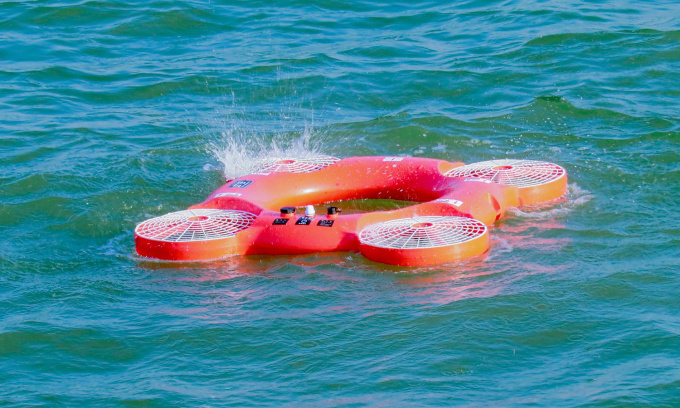China's TY-3R drone can keep two adults afloat, has a communication range of 1.1 km and can operate for 10 minutes on a single charge.

A lifebuoy-drone hybrid that can take off and land right on the water. Photo: Didiok Makings
Chinese drone company Didiok Manufacturing has created the "TY-3R Flying Buoy," a hybrid of a quadcopter drone and a life buoy, New Atlas reported on April 29. When rescuers on shore discover a person in distress swimming at sea, they can activate the TY-3R, which will quickly fly to the swimmer and land on the water, transforming into a life buoy. The swimmer can use it as a flotation device. Rescuers will then have time to get a rescue boat and drive to the location of the incident, bringing the victim back to shore.
The TY-3R takes off with just a push of a button on the remote controller. While flying to the designated location, the drone also provides the operator with a real-time view with its built-in 720p camera. Once the victim is rescued and no longer needs to rely on the drone to float, the operator just needs to press a button to automatically fly back to the take-off location according to GPS coordinates. Notably, it is capable of taking off right on the surface of the water.
The TY-3R can support two adults floating on water, has a communication range of 1.1 km, a maximum speed of 47 km/h and an operating time of more than 10 minutes per battery charge. This drone weighs less than 5 kg and is waterproof to the IP68 standard. This means it will not be damaged when submerged at a depth of 1 m for 30 minutes.
When it lands on the water, the TY-3R shuts down its engines. Additionally, the drone has shields on its propellers to better protect swimmers. The vehicle is currently priced at $11,803.
This is not the world's first swimmer rescue drone. Vehicles such as Pars (USA), Little Ripper (Australia), Auxdron (Spain) are also capable of performing this task, but their method is to drop separate flotation devices to the victim instead of landing directly in the water.
Thu Thao (According to New Atlas)
Source link



![[Photo] General Secretary To Lam received the delegation attending the international conference on Vietnam studies](https://vphoto.vietnam.vn/thumb/1200x675/vietnam/resource/IMAGE/2025/10/26/1761456527874_a1-bnd-5260-7947-jpg.webp)
![[Photo] Enjoy the Liuyang Fireworks Festival in Hunan, China](https://vphoto.vietnam.vn/thumb/1200x675/vietnam/resource/IMAGE/2025/10/26/1761463428882_ndo_br_02-1-my-1-jpg.webp)


![[Photo] Nhan Dan Newspaper displays and solicits comments on the Draft Documents of the 14th National Party Congress](https://vphoto.vietnam.vn/thumb/1200x675/vietnam/resource/IMAGE/2025/10/26/1761470328996_ndo_br_bao-long-171-8916-jpg.webp)
































![[Photo] Prime Minister Pham Minh Chinh attends the opening of the 47th ASEAN Summit](https://vphoto.vietnam.vn/thumb/1200x675/vietnam/resource/IMAGE/2025/10/26/1761452925332_c2a-jpg.webp)










































































Comment (0)